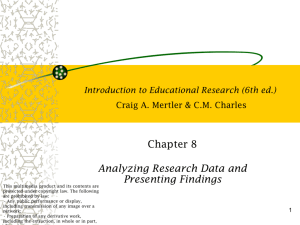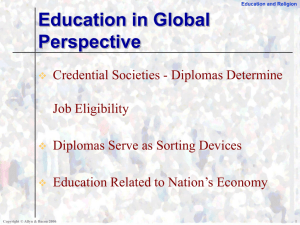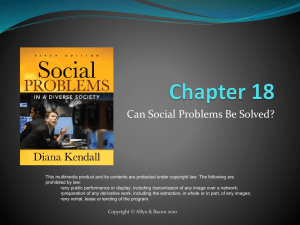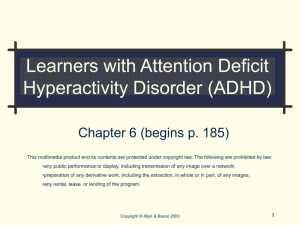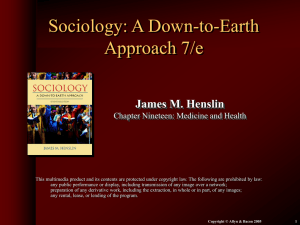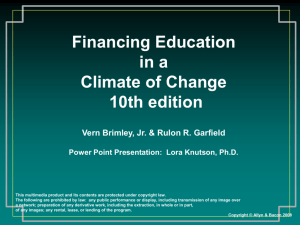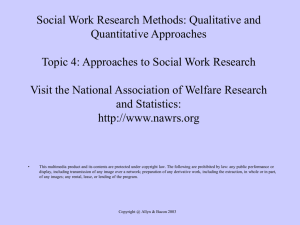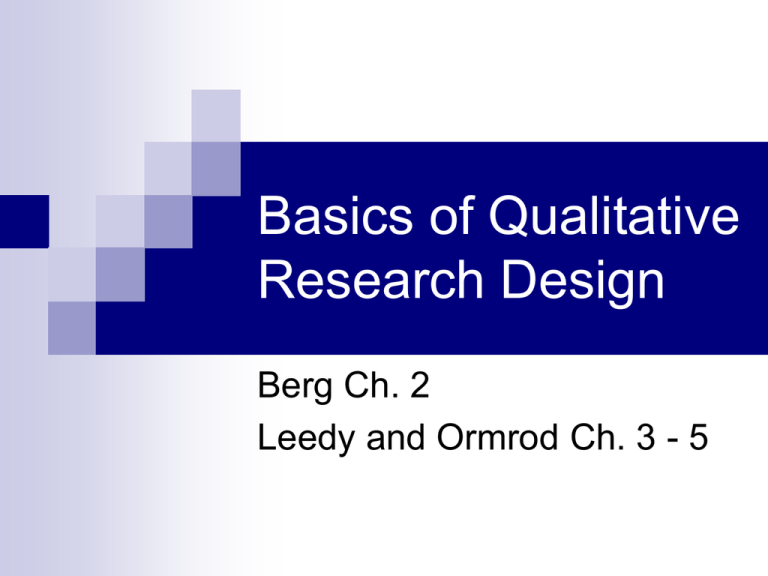
Basics of Qualitative
Research Design
Berg Ch. 2
Leedy and Ormrod Ch. 3 - 5
Three General Approaches to
Research
APPROACH POSITIVISM CRITICAL
INTERPRETIVE
USUAL TYPE
OF RESEARCH
experiment,
survey,
cont. anal.
historicalcomparative
field research,
interviews
PERSPECTIVE
technocratic
transcendent
transcendent
TYPE OF LOGIC
reconstructed logic-in-practice logic-in-practice
PATH
linear
non-linear
/cyclical
non-linear
/cyclical
Qualitative methodology
Data in words rather than numbers
Non-positivistic orientation
Includes:
Field
research and ethnography
Observation, case studies
Qualitative interviewing
Action research
Historical comparative analysis
Characteristics of Qualitative
Research
Context is critical
In depth, detailed
Researcher immerses self in data (nonobjective)
Researcher integrity
Bias recognized
Use of grounded theory
Can detect process and sequence
Data are interpreted rather than analyzed
Ideas and Theory
The Deductive
(Quantitative)
Process
Ideas and theory
come before
empirical research
Ideas lead to
refutation through
research
Copyright © Allyn & Bacon 2010
The Inductive
(Qualitative)
Process
o Research leads to
theory development
o Research initiates,
reformulates, deflects
and clarifies theory
What is Theory?
“a statement of relationships between
concepts”
“a roadmap for organizing ideas and
knowledge about the social world”
Theory Parts
Concepts
Concept
clusters
Classification concepts (ideal types)
Assumptions
Typology or Taxonomy
Relationships
The Measurement Process
Quantitative = deductive
Qualitative = inductive
Both involve conceptualization and
operationalization
Concepts
Symbolic
elements
Foundation of communication and
thought
Two distinct parts
Symbolic
elements (word, symbol, term)
Definitional element
Copyright © Allyn & Bacon 2010
Operationalization of a
Concept
Conceptualize
Providing
a working definition of a concept
Use theory and research
Operationalize
providing
the criteria for measuring a concept
What, specifically, will you be observing?
Often continues throughout the research
process
Copyright © Allyn & Bacon 2010
Process of Qualitative
Operationalization:
Empirical Observations
Working Ideas
Concepts
Generalizations/Theories
Berg’s Blended Model
The
Spiraling Research Approach
Begin with a rough idea
Gather theoretical information
Reconsider and redefine
Process: Idea
-- Lit. Review (involves Theory)
-- Design
-- Data Collection/Organization
-- Analysis/Findings
--Dissemination
Copyright © Allyn & Bacon 2010
Choosing a Research Problem
Where do problems come from?
Practical
problems in the field
The literature in the field
Personal interest
Examples of Problems:
The purpose of this study is to examine
the effect of body image and PPF
(perceived physical fitness) for different
exercise settings
The purpose of this study is to examine
the type of talk during a writing activity to
determine if there is a difference between
off topic and on topic talk on the quality of
students’ writing samples
Reviewing the Literature
Recommended Sources:
Journal
articles
Books
Conference
proceedings
Government / corporate reports
Library Databases
Other Sources (not recommended)
Newspapers
and Magazines
Internet esp. sites like Wikipedia
The Annotated Bibliography
A very useful first step…
Consists of a bibliographic citation and a
descriptive and evaluative annotation of a
selection of your most useful sources
Reviewing the Literature
Formulate
a rough question
Visit the Library
Conduct
both online and in-print
searches
Make
a list of search terms
Evaluate the results
Copyright © Allyn & Bacon 2010
Evaluating Web Sites
Information to check
URL
Domain
Date of last update
Corroborating information
on every website
Copyright © Allyn & Bacon 2010
Writing The Literature Review
Concentrates on the scientific research
Provides the context for your research
Justifies the proposed study
Summarizes and evaluates the literature in
the field
Questions to be answered in a
literature review:
1. What do we already know in the immediate area concerned?
2. What are the characteristics of the key concepts (or the main
factors or variables)?
3. What are the relationships between these key concepts,
factors or variables?
4. What are the existing generalizations or theories?
5. Where are the inconsistencies/shortcomings in our knowledge
and understanding?
6. What views need to be (further) explored?
7. What information or evidence is lacking, inconclusive,
contradictory or too limited?
8. Why study (further) the research problem?
9. What contribution can the present study be expected to make?
10. What research designs or methods seem unsatisfactory?
Tips:
Remember the purpose
Read with a purpose
Write with a purpose
Always put citations into your writing
immediately
Keep a bibliographic file
Berg’s Two-Card Method
Author
Full
Card
citation
Library call
number
o Topic Card
oAuthor’s name
oDate of
publication
oBrief topical
label
oVerbatim excerpt
Copyright © Allyn & Bacon 2010
Janesick (1994) in Berg….
“design is the choreography
that establishes the
research dance”
What
are the implications of this
statement?
The Research Design
The plan for conducting a study
Foresee possible glitches
Consider appropriate pacing
Appraise ethical proprieties
Feasibility is contingent on many factors:
Length of time to do the study
Ethical constraints
Cooperation of others
Cost of conducting the research
Researcher’s own skills
Setting
Identification
of a data-collection site
Practical
entry
or access - gatekeepers
availability
Reasonable
in size and complexity
Appropriateness
Copyright © Allyn & Bacon 2010
Sampling Strategies
Probability
Sampling
Mathematically
representative of the larger
population
Relies on random sampling
Non-Probability
Sampling
Doesn’t
require a list of the population elements
Can be used with difficult or sensitive populations
Copyright © Allyn & Bacon 2010
Probability Sampling
Simple
Random Sampling
Every unit has the same chance of inclusion
Systematic Random Sampling
Every nth unit is selected from the list
Stratified Random Sampling
Independent samples from subgroups of the
sample
Cluster Sampling
Clusters are randomly and elements within are
randomly selected
Copyright © Allyn & Bacon 2010
Non-probability Sampling
Convenience
Samples
Relies on available subjects
Purposive Samples
Researcher knowledge or expertise
Snowball Samples
Respondent-driven
Quota Samples
Proportional matrix
Data Analysis
Data
Reduction
Reduce
Data
and transform the data
Display
Organize
and assemble the data
Conclusions
and Verification
Confirm
initial conclusions through
double checking and independent
examination
Copyright © Allyn & Bacon 2010
Dissemination
Writing the final report on your research
for publication or presentation to a funding
agency
Integral part of the research process

